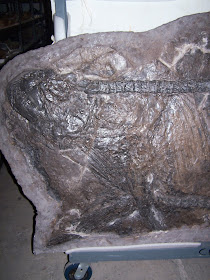Due to the numerous pictures uploaded to Pinterest by the Best Western Denver Southwest hotel (read more about it HERE), I'm going to be using a lot of pictures from this site! Make sure you check it out by clicking HERE! Unless otherwise noted, photo credit for all of the pictures in this post goes to that Pinterest page!
Why did I call Xiphactinus (pronounced zye-FACT-un-us) "The Inception Fossil?" Well, that's a description that I came up with (don't ever let anyone tell you otherwise!) that has to do with one of the most interesting things about Xiphactinus: numerous specimens of the fish have been found with the remains of other fish in its stomach! Just as the premise behind Inception is "a dream within a dream," so too are specimens of Xiphactinus sometimes "fish within a fish!" The specimen below is a thirteen foot Xiphactinus that died with a fish known as Gillicus arcuatus in its stomach!
Unlike sharks, Xiphactinus would have been unable to bite off chunks of flesh from its prey, and instead would have had to swallow its prey whole, which is what makes the Inception Fossils so spectacular! Some paleontologists propose that this lack of chewing may have been what killed some of these Xiphactinus specimens, and that they actually choked to death on their last meal! I suppose it's possible, but I don't actually know enough about these specimens to be a very good authority on them!
The next three pictures below are pictures that I took of a specimen that I saw a week or so ago. Long story short, my friends Isabel and Sam Lippincott and I had gone to a presentation given by paleontologist Dr. Ian Miller about the Snowmastodon Project a few months back, and he was impressed with Sam's paleo drawings when we showed him after the lecture. He invited us to come on down to the Denver Museum of Nature and Science so that he could show us around behind the scenes, which he very kindly did a few weeks ago! These are pictures I took of the 80 MY old Mancos Shale specimen of Xiphactinus, which was discovered in 1966 by some kids who had been hunting with their dad near Snowmass in Colorado. They had stumbled across the rib cage of the animal, and had notified the Denver Museum. The next summer, the museum excavated the remarkably complete, 13-foot specimen, taking it back to the museum, where it has been stored to this day!
Here are some more cool pictures from the Pinterest page! This is a diorama of paleontologist Charles Sternberg caught in the act of discovering one of his "Inception fossils!"
And here are another pair of reconstructions of Xiphactinus!




No comments:
Post a Comment